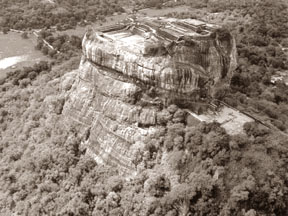|
observer |
|
|
|
|
|
OTHER LINKS |

|

|

|
Deconstructed:The mystique of SigiriyaSri Lanka's topless Sigiri fresco women, sublime and etched on rock walls between 477 to 495 A.D. are as elusive in identity to historian as the name and personality of Mona Liza, painted by Leonardo da Vinci. In like mode, there are many interpretations of the Sigiriya period, history gorged with legend, passion, and betrayal. Of the founder of Sigiriya, too, riddle lingers, but some things are known. He was King Kasyapa. He came from Anuradhapura, the then, established capital of the Indian Ocean island.
Some historians have said that Sigiriya was a Buddhist monetary, before Kasyapa acquired it. Wicked, though Kasyapa's heart may have been, he was born with the soul of an artist. Bards have dwelt in musical timbre, on this King. The epic of Sigiriya continues to be sung by archaeologists, historians, writers and movie makers. Every act, has attempted to capture the spirit and personality of Kasyapa, and an English movie, on Sigiriya, was titled, "The God King." Eighteen years after Kasyapa founded Sigiriya, Moggallan mustered an army from India and challenged him. The armies are supposed to have met close to the citadel. It is puzzling how Moggallan got so close to the mighty Sigiriya rock. For, Sigiriya, is a watchtower in itself. In those days, all kingdoms were well fortified with watchers, from near and far, and the many rocks around Sigiriya would have functioned as spy towers. The king could have been alerted by relay systems of smoke, arrows and runners. Moggallan's army could have been highly disciplined. Perhaps, the army travelled by night. Some say that the army's day movements would have been restricted to single soldiers, covered with leaves, moving at snail pace. In those days, in India and Sri Lanka, soldiers went to war riding on the backs of elephants. Kasyapa came down from the palace to meet the invading army, riding his elephant. The soldiers who followed him to battle, found the terrain, too boggy, and turned their elephants to another route. Kasyapa, turned his head around and in a moment of mistaken judgement, the King thought that his army was deserting him. Not wanting to fall into the hands of his brother, Kasyapa drew his dagger and slew himself. The grandeur and splendour of Kasyapa's palace was not to be the liking of Moggallan after he defeated the patricideist, and the kingdom was handed over to the Buddhist monks. Hundreds of tourists climb this Lion Rock every day to see for themselves, the mystical abode of Kuvera, the God of Wealth and bare their faculties to the phenomena of the fortress in the sky, its mystery and pleasure and possibly, sin. |
 One legend has it that Kasyapa walled his father to death, because of
his refusal to reveal where some treasure lay. Kasyapa, feared the wrath
of his half-brother, Moggallan, and built for himself on the gigantic
Sigiriya rock, the mighty fortress-palace and city modelled on the
mythical abode of Kuvera, the God of Wealth. Today, Sigiriya is claimed
my many authorities to have been the 8th Wonder of the World.
One legend has it that Kasyapa walled his father to death, because of
his refusal to reveal where some treasure lay. Kasyapa, feared the wrath
of his half-brother, Moggallan, and built for himself on the gigantic
Sigiriya rock, the mighty fortress-palace and city modelled on the
mythical abode of Kuvera, the God of Wealth. Today, Sigiriya is claimed
my many authorities to have been the 8th Wonder of the World. 





